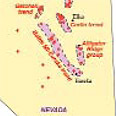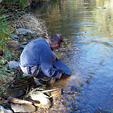All Articles
Legislative and Regulatory Update
August 2004 by Staff
• States can manage their own roadless areasThere are several additional Federal Register notices that will be published soon regarding forest management and the Roadless Rule. In fact, they may have been published by the time you read this column.
We obtained advance copies of the notices prior to their publication. As currently written, they will include a 60-day comment period. We will publish the comment deadlines and addresses in an upcoming issue, and our readers should have plenty of time to submit comments.
The Bush administration intends to replace the January 12, 2001 Roadless Area Conservation Rule that was declared illegal by US District Court Judge Clarence A. Brimmer in July 2003. The decision is still being appealed by environmental groups, but there were an additional 8 lawsuits filed in federal courts. Over 58 million acres were to be designated roadless, mostly in the Western States, under the Roadless Rule.
The new rule will propose to allow governors of the 39 states affected by the Roadless Area Conservation Rule to petition the Department of Agriculture (USDA) to manage their own roadless areas. The petitions would have to be filed within 18 months of the date the Federal Register notice is published, and would have to include “specific information and recommendations for the management requirements for individual inventoried roadless areas within a particular State.”
The USDA is considering providing an advisory committee to guide individual States through a State-specific rulemaking process.
The new rule will provide Western States with the opportunity to control their own roadless areas, which was the predominant reason why lawsuits were originally filed. Ninety-seven percent of the roadless areas designated were in the Western states of Alaska, Montana, Idaho, Wyoming, Washington, Utah, Oregon, New Mexico, Nevada, Colorado, California, and Arizona.
This new approach appears to be a more rational way to manage roadless areas, granting more local input and control, rather than a blanket approach that doesn’t take into account varying opinions.
The other Federal Register notice will reinstate an interim directive that expired in June 2003. It will reinstate the authority of the Forest Service Chief to make decisions regarding inventoried roadless areas.
The directive will include two changes. First, it will allow the Chief to grant project-specific exceptions on a case-by-case basis. Second, it revises the authority and the responsibility of the Regional Forester for decisions on a road construction or road reconstruction project in an inventoried roadless area, including all lands associated with any mineral lease, license, permit or approval issued for mineral leasing operations. The notice states this adjustment was made in order to eliminate confusion concerning the minerals leasing program in inventoried roadless areas that involve protracted, staged decisionmaking, as well as in consideration of the interests set forth in the National Energy Plan.
• Forest lands and suction dredging
We don’t intend to turn our mining publication into a forest publication, but there is much to report on coming out of the Forest Service.
Public Lands for the People (PLP) recently obtained a memo sent out to Forest Supervisors in the Pacific Southwest (Region 5—California). The memo is dated May 24, 2004, and is titled, “Forest Service Regulation of Suction Dredging Operations.”
The memo directs the Forest Service to regulate all suction dredging on Forest Service lands in the Pacific Southwest. It says that authority to regulate is provided in the Code of Federal Regulations, specifically 36 CFR 228 Subpart A, and includes the fact that it does not regulate mining as a recreational activity.
The memo states that “a suction dredge is mechanized earthmoving equipment and such operations are not exempt” from filing a Notice of Intent or a Plan of Operation to the District Ranger for review. The District Ranger is to make a determination whether or not a Plan of Operation is required.
The memo continues, “Suction dredging operations are exempt from federal mining law and regulations only if the waters have been adjudicated as navigable waters. Under statehood provisions, navigable waters are controlled by the state and the beds of such waters are state property. However, this is a moot issue since the navigable streams and rivers in California were determined long ago, and there are none within the boundaries of California’s National Forests. Therefore, the lands beneath the rivers and streams on National Forest System lands are federal lands and the Forest Service has the authority to regulate the mining operations.”
The memo directs the District Rangers to include occupancy, camping, fuel and equipment storage, campfires and similar uses when determining whether or not there is a significant disturbance that would warrant a Plan of Operation. A Plan of Operation would require a biological assessment/biological evaluation in accordance with the National Environmental Protection Act (NEPA), an Endangered Species Act consultation and financial guarantees (bonding).
The memo is from Regional Forester Jack Blackwell.
PLP believes the memo flies in the face of the recent Lex-Waggener court decision (published in our January 2004 issue) that directs what the Forest Service can and cannot regulate by making up their own rules. PLP maintains that 36 CFR 228.4 only gives the Forest Service the authority to regulate earthmoving equipment such as backhoes and bulldozers, and to regulate the cutting of trees, as stated by Judge Lawrence K. Karlton in the Lex-Waggener case.
PLP also believes that California maintains the authority to regulate all the waters in the state. The state comprises all of the rivers, not just navigable waters. California completed an Environmental Impact Study, brought their laws into compliance with federal laws, and the state issues its own suction dredge permit.
According to 16 U.S.C. § 481, Use of Waters: All waters within boundaries of national forests may be used for domestic, mining, milling, or irrigation purposes under the laws of the state wherein such national forests are situated or under the laws of the United States and the rules and regulations established thereunder (emphasis added).
The key wording in 16 U.S.C. § 481 is “…or under the laws of the United States…” It does not say the state and federal government can regulate the use of waters. If the state chooses not to regulate the use of waters then the Forest Service can.
If you would like to get into this fight, join PLP, or assist with information, time or donations, you can contact Jerry Hobbs at (909) 889-3039.

A Guide to Overlooked Gold Deposits—Part IV
 Trends are geologic situations in which the geological structure of an area is conducive to the deposition of minerals. These structures are generally fault systems that can be small and localized or can run for miles.
Trends are geologic situations in which the geological structure of an area is conducive to the deposition of minerals. These structures are generally fault systems that can be small and localized or can run for miles.
Gold Prospecting for Better or Worse: The Disappearing Nuggets
 Gold probably is one of the easiest things in the world to cheat an absentee owner out of. He would generally have no way of really knowing if a guy had found 3 nuggets or 30 nuggets on his claim.
Gold probably is one of the easiest things in the world to cheat an absentee owner out of. He would generally have no way of really knowing if a guy had found 3 nuggets or 30 nuggets on his claim.
Copper Price Keeps Canadian Miners Busy
The Canadian copper industry is benefiting from the current high metal prices, and exploration activity should remain high over the coming year as new mines are developed and continuous improvement programs increase efficiencies at existing operations.
The Historic Gold Rush Town of Quincy
 …we focused on various layers of hard-packed flood material out of the creek, and we also obtained some material up quite a ways from the creek itself on bedrock.
…we focused on various layers of hard-packed flood material out of the creek, and we also obtained some material up quite a ways from the creek itself on bedrock.
Mining Claims—What to Know Before You File
During the initial assessment year (the year of location), the claim maintenance fee must be paid at the time the notice of location is filed with the Bureau of Land Management. Failure to pay the claim maintenance fee will void the claim.
The Bawl Mill
• An idea that is overdue...
• Oh Lord, won’t you buy me a Mercedes Benz?
Mines and Money
The “Mines and Money” gathering, held in Vancouver, BC, on May 20-21, was geared toward the upper levels of world mining executives. As such, the presentations were of a different nature than any of the gatherings covered in our publication earlier this year.
Subscription Required:
The Bawl Mill
• Lawsuit to Challenge New Forest Service Regulations
• Gold in Utah Laccoliths
• Where Do I Begin?
• Looking Back
• Mine President Seeks Opinions From Peers
• Over The Divide
• Picks & Pans: Miner Finds Heart of Gold
• Company Notes
• Canadian Arrow Tries Different Approach
• Greenstone
• Experts Forecast Rising Prices for Gold, Silver
• A Few Reminders About Fraud
• Mining: Doing it Right the First Time
• Prospectors & Treasure Hunters Find Gems
• The Golden Highway—El Dorado County
• Melman on Gold & Silver
• Mining Stock Quotes and Mineral & Metal Prices
Free:








